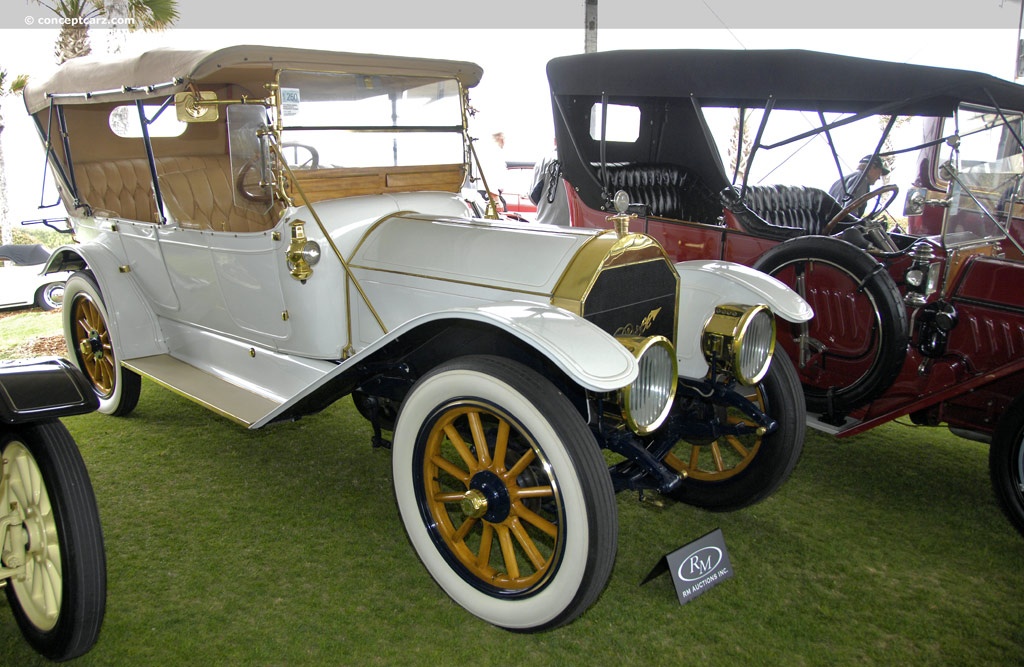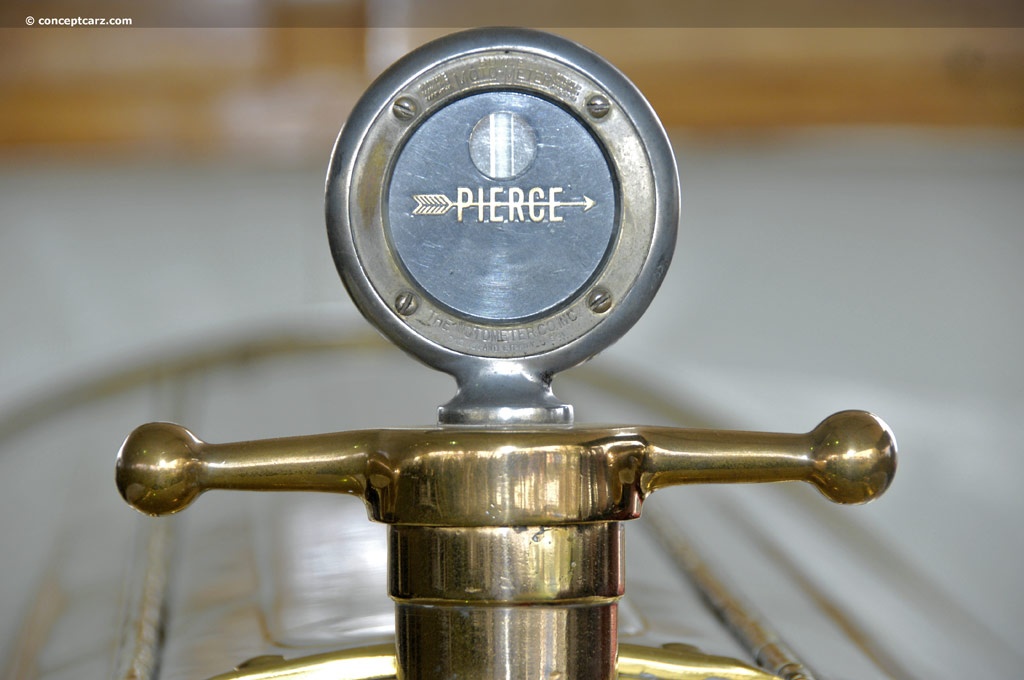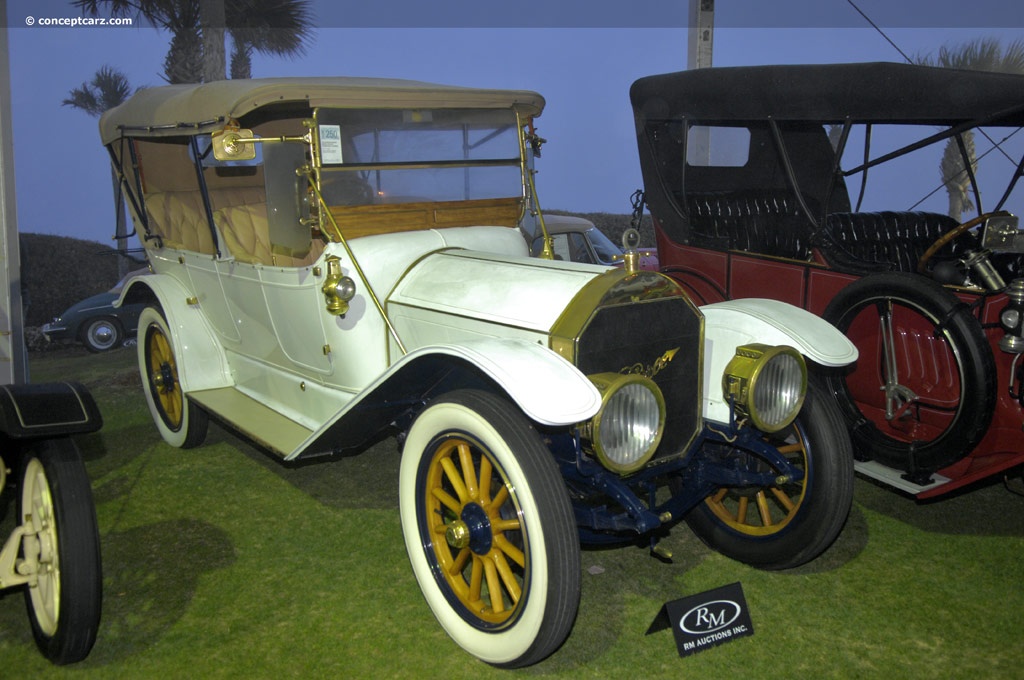The origins of the Pierce-Arrow company began with birdcage designs and household items. Established in 1865 as Heinz, Pierce, and Munschauer, George Norman Pierce bought out the other two principals of the company in 18972 and changed the name to the George N. Pierce Company. Bicycles were added to the product line in 1896 and by 1901 were building single-cylinder, two-speed, Moterette's. In 1903, they produced a two-cylinder car called the Arrow, followed by a larger and more luxurious version the following year, dubbed the Great Arrow. They won the Glidden Tour in 1905, and in 1908 the company was renamed as the Pierce-Arrow Motor Car Company.
Touring
Chassis #: 66500
Engine #: 66500
View info and history
Auction entries : 2Pierce's son Percy had driven a four-cylinder Great Arrow to victory in the inaugural 1905 Glidden Tour, and Pierces would take the Glidden trophy for the next four events. The words 'Pierce' and 'Arrow' became intertwined in the public eye that both car and company became 'Pierce-Arrow.' By this point in history, pricing for the Pierce-Arrows ranged from $3,050 to $7,200 and was among the most expensive and prestigious vehicles on the road, having joined Packard and Peerless in comprising the 'Three Ps' of luxury American motor manufacture. The engineering of the early Pierce cars was principally the work of a British-born engineer of Scots ancestry, David Fergusson. He joined Pierce in 1901 and created the design for the company's Motorette and Arrow models. In 1905, he and manufacturing vice-president Henry May toured Europe, visiting automobile factories and studying design trends and manufacturing methods. They observed that many manufacturers of large and luxurious automobiles had moved to six-cylinder cars. Following the trend, Pierce-Arrow utilized six-cylinder power for the next 15 years.Pierce introduced its first six-cylinder model in 1907, called the Model 65-Q. It used a T-head configuration, just like the fours that preceded it, with a 648 cubic-inch displacement. The engine was installed in a 135-inch wheelbase that was nearly a foot longer than the largest four-cylinder model, and a fully clothed example weighed approximately 4,000 pounds. With the introduction of the 65-Q, Pierce moved upmarket and its pool of capable buyers became smaller, thus approximately 100 examples were built, as opposed to 900 fours. In 1908 the company added a smaller, 40-horsepower six, the 40-S, and another derived from the 24-horsepower four-cylinder 24-T. The final Pierce four-cylinder models were built in 1909. The following year, the Pierce lineup included three sixes comprised of the 36-UU (wheelbase of 119 and 125 inches), the 48-SS (128- and 134-inches), and the Model 66-QQ (133 or 140-inch chassis). Successive models of 38, 48, and 66 horsepower would comprise the Pierce catalog through 1918. 
Touring
Chassis #: 66500
Engine #: 66500
View info and history
Auction entries : 2Within a short period of time, the Pierce-Arrow Motor Car Co. of Buffalo, New York had become renowned as the most prestigious supplier of six-cylinder cars in the United States. Through Avant-grade engineering, superb craftsmanship, and the most innovative engineers in the auto industry, the Pierce-Arrows were the first to employ power steering, power braking, hydraulic tappets, and light alloy in their construction. Despite the company typically being at the forefront of technology and design, it clung to right-hand steering until 1920. In 1910 the company introduced the Model 66, named for its rated horsepower. The bore measured 5.25 inches and the stroke of 5.5 inches, giving it a displacement of 714 cubic inches. Production of these hand-built vehicles lasted until 1918 with 1,250 examples produced. They were powerful, stately, and the quintessential embodiment of opulence and luxury. The 1911 and 1912 Pierce models were largely carryovers of the prior 1910 line. 1913 brought significant changes including the hallmark fender-mounted headlamps. The 714 cubic-inch powerplants grew even larger to 824.7 cubic inches with horsepower increasing to nearly 100 hp, however, the Model 66 designation remained. The engine, comprised of three paired castings equated to six cylinders, was backed by a four-speed manual transmission with braking controlled by two-wheel mechanical drums. The suspension had a solid axle in the front with semi-elliptical leaf springs and a live axle in the back with three-quarter elliptical leaf springs. The longer stroke and added horsepower gave the Model 66 (albeit Model 66A) a top speed of 80 miles per hour. The wheelbase grew to 147.5 inches and would continue to use this platform for the remainder of the model's lifespan. Herbert M. Dawley joined Pierce in 1912 and was responsible for the fender-mounted headlamps. This setup provided greater illumination in both width and distance. Catering to nearly every customer demand and desire, Pierce-Arrow continued to offer conventional lights.
Touring
Chassis #: 66500
Engine #: 66500
View info and history
Auction entries : 2The interior featured a comprehensive set of dials and instrumentation including a Stewart-Warner clock with second hand, a Warner Auto-Meter (odometer), and a drum speedometer on top, with oil and gasoline gauges and a Westinghouse voltmeter below. A temperature gauge was located on the toeboard. To the right of the driver were the shift and brake levers. A horn bulb was attached to the steering column and operated a Tally-O-Horn in the engine compartment. Pierce-Arrow pioneered thin-cast aluminum panel work in its bodies, making them lighter and stronger than the wooden bodies or metal paneled wooden frameworks used by competitors. An electric starter was added in 1914 and pressurized fuel delivery (using an engine-operated air pump to pressurize the fuel tank) in 1915. In 1916, the final Model 66 Series 4 was introduced and continued in production through 1918. A number of lightweight aluminum parts were used in the engine which had dual ignition from both a coil-and-battery system and a magneto. The large engine consumed a gallon of fuel every 8.5 miles, and with the 36-gallon gas tank, the Model 66 had a range of nearly 300 miles. 
Touring
Chassis #: 66500
Engine #: 66500
View info and history
Auction entries : 2For many years, the Pierce-Arrow Model 66 was listed in the Guinness Book of World Records for having the largest engine ever installed on a passenger vehicle.Currently, only 14 examples of the Model 66 remain with seven of those being the Model 66 A-4 series.
by Daniel Vaughan | Jun 2020

Touring
Chassis #: 66500
Engine #: 66500
View info and history
Auction entries : 2

Touring
Chassis #: 66500
Engine #: 66500
View info and history
Auction entries : 2

Touring
Chassis #: 66500
Engine #: 66500
View info and history
Auction entries : 2

Touring
Chassis #: 66500
Engine #: 66500
View info and history
Auction entries : 2
by Daniel Vaughan | Jun 2020
Related Reading : Pierce-Arrow Model 66 History
The Pierce-Arrow Model 66 was one of the pinnacles of American design and craftsmanship of the early Twentieth century. Just like all Pierce Arrows since 1910, they were powered by a six-cylinder engine. Originally they had a bore of 5.25 inches and a stroke of 5.5 inches giving it 714 cubic inches of displacement. By 1913 it had grown to have a bore of 5 inches and a stroke of 7 inches. The engine....
Continue Reading >>
Continue Reading >>
Similar Vehicles
Similar Automakers
1912 Pierce-Arrow Model 66 Vehicle Profiles
Recent Vehicle Additions
Performance and Specification Comparison
Price Comparison
$4,039 - $4,944
$4,850 - $6,450
Model 66 Specification Comparison by Year
Year
Production
Wheelbase
Engine
Prices
Related Automotive News

Volvo P1800 Cyan heads to Monterey Car Week
Swedish builder to debut first US customer commission alongside original prototype at The Quail, A Motorsports Gathering
Volvo P1800 Cyan also headed to Concorso Italiano to celebrate the ItalianSwedish design heritage of the Volvo P1800
After...

Original Aston Martin DB4 GT Continuation Car, With Delivery Miles, Comes To Market Via Aston Martin Works
2 July 2020, Newport Pagnell, Buckinghamshire The hugely successful Aston Martin Continuation car programme, which started in 2017 with the DB4 GT Continuation, has set the standard for the creation of new-build heritage cars around the world.
With...

2017 Ford GT Headlines American Performance Cars at RM Auctions Auburn Fall Sale
JIM MANGIONE CORVETTE COLLECTION BRINGS AMERICAS SPORTS CAR TO THE AUBURN AUCTION PARK
RM Auctions to offer exceptional lineup of American performance and sports cars at Auburn Fall auction, 29 August – 1 September
Group led by 2017 For...

THE McLAREN F1
FOR THE DRIVER VITALLY – AS IN ONE OF McLARENS WORLD CHAMPION RACING CARS – DRIVER AND VEHICLE BECOME ENTIRELY AS ONE
The primary design consideration for the McLaren F1 has been to make it without reserve a drivers car, an extremely high-performance...

GENERAL MOTORS GALORE AT MECUM KISSIMMEE 2016
69 Trans Am Convertibles, 69 ZL1s and Featured Corvettes at Auction, Jan. 15-24
Walworth, Wis. – Jan. 12, 2016 – As the worlds largest collector-car auction featuring 3,000 vehicles, Mecum Kissimmee is unequaled in its variety of mak...




















